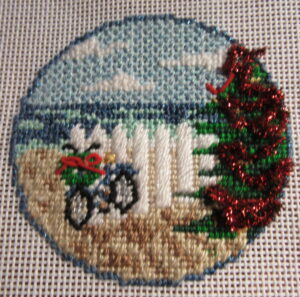
Updated December 10, 2023.
With the many different threads and stitches available to us as needlepointers, it’s easy to agree with the saying “This is not your Grandmother’s needlepoint!” We’ve come a long way from the days when endless streams of Continental were done by dignified ladies. This is a very good thing.
Having so many threads to choose from, and so many stitches at our disposal makes making lovely needle art easy — or is it?
It’s all too easy for a canvas to get overwhelmed by too many textures, colors, threads, and stitches, so that the piece loses its focus and looks like a mishmash instead of something worth the work you put into it.
There are some great guidelines for making your needlepoint piece work and these will help you pick stitches and threads and will make your finished work worth the effort.
When you get a new canvas and are thinking about how to stitch it, decide which things in the piece will be your focal points. There should be one major focal point and there may be a very few additional focal points. The focal point is the most important area of the design and all the stitching everywhere in the piece needs to support it.
Next choose the threads (and maybe the stitches) for your focal point. These should be threads and stitches that make the focal point come towards the viewer. So for example, if your background is going to be wool, make the focal point silk or pearl. Use a more textured stitch or a lighter color.
You can pick and choose stitches for your design as you go, adding some texture here picking a different thread there.
But keep in mind while you work what I call “Mary Shipp’s Rule.” Mary is an amazing stitcher and teacher and one of my mentors. She says that there are three aspects of needlepoint — thread, color and stitches. The line between lovely needleart and confusion is in how many of each of these you use.
In good needle art, one of these should be dominant, another should be “just an accent,” and the third should be somewhere in the middle. In fact, she uses the proportions 1-3-5 to demonstrate this.
For example, if you are doing a piece in all wool, you could have lots of colors (say a bouquet of flowers) and relatively few stitches (maybe one stitch for the leaves and another for the flower center). But you could also have lots of stitches (maybe all the different furs of animals in a Noah’s Ark piece). And in that case, your colors would mostly be browns and tans.
But what if you made every flower a different stitch or every animal a fanciful color? You can probably imagine how confused this would look.
When you plan to stitch a canvas, start with the focal point and then move on as you stitch (which is what I do) or as you plan, keeping in mind Mary’s rule.
And if you start to feel as if you have gone too far — evaluate the piece according to the rule and make adjustments. Don’t be afraid to rip things out if the piece isn’t working. a piece which you will finish is much better than one that will languish in your stash.
About Janet M Perry
Janet Perry is the Internet's leading authority on needlepoint. She designs, teaches and writes, getting raves from her fans for her innovative techniques, extensive knowledge and generous teaching style. A leading writer of stitch guides, she blogs here and lives on an island in the northeast corner of the SF Bay with her family
[…] Stitching Order & Focal Points in Needlepoint […]